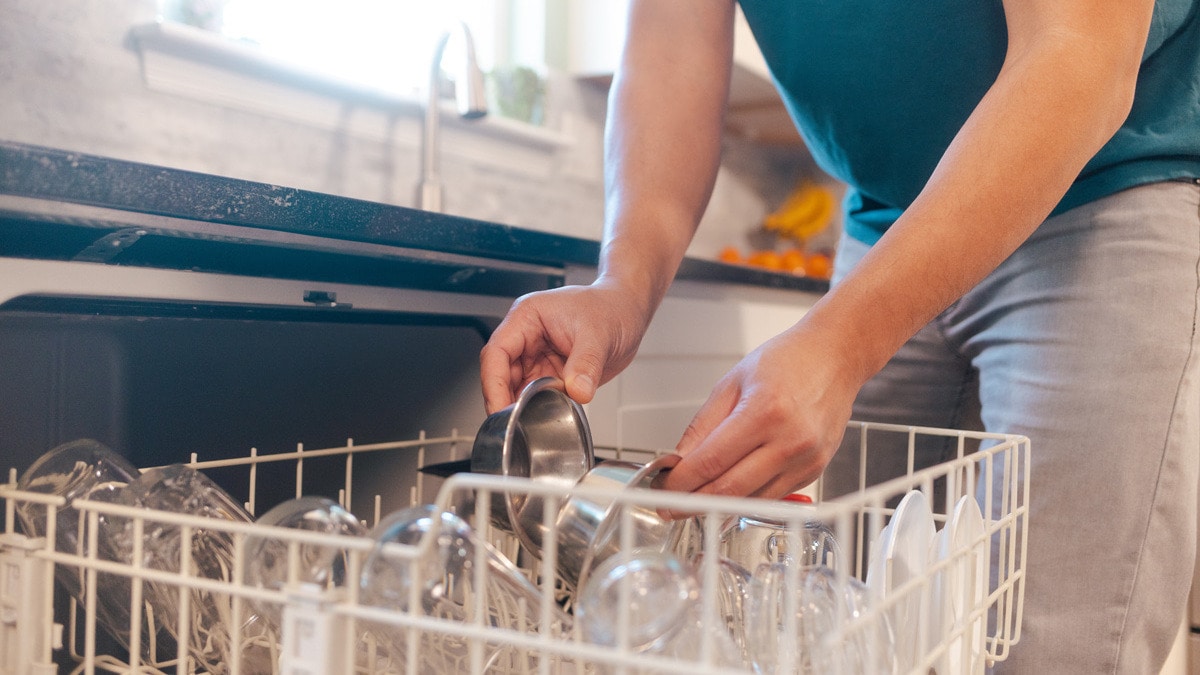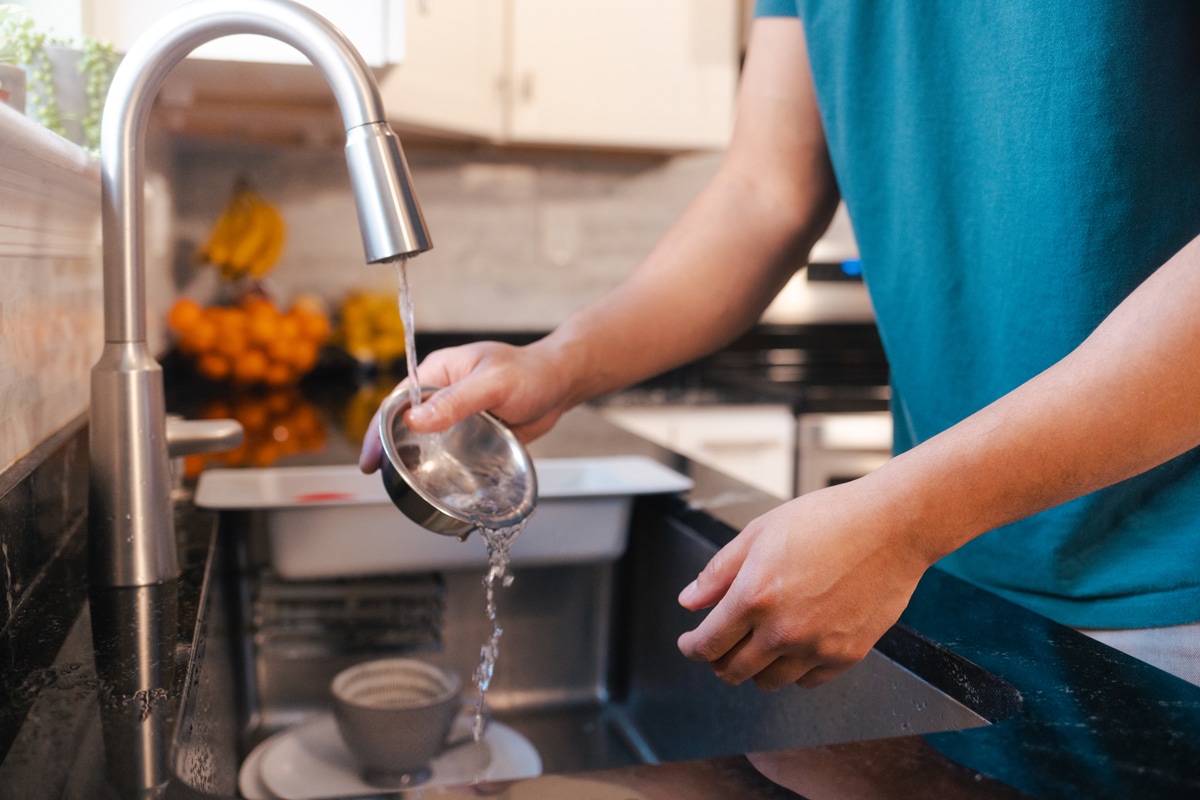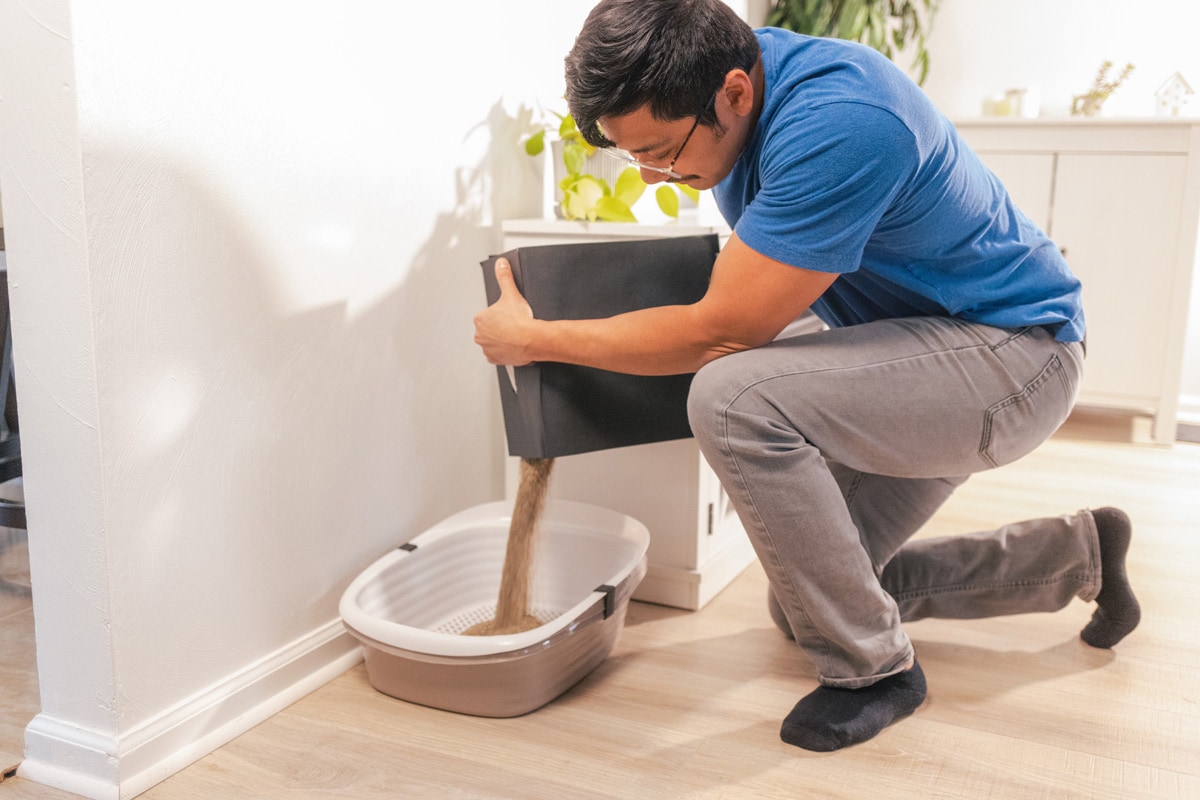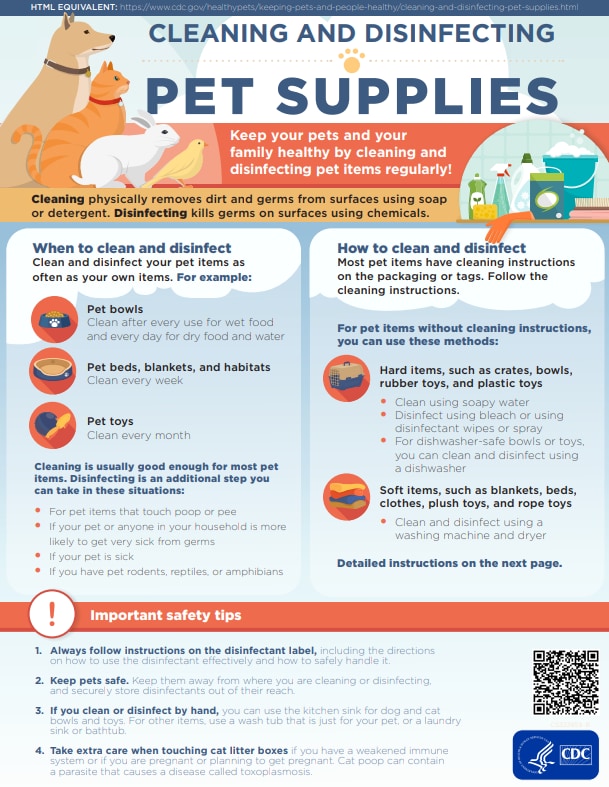What to know
- Pet items like bowls, toys, and leashes can sometimes be contaminated with germs.
- Clean and disinfect pet items frequently.
- Always read and follow instructions on the label for cleaners and disinfectants.

Overview
Pets, like people, naturally carry bacteria and other germs
We love our pets. Many of us have pet dogs and cats, while some of us have pet reptiles, birds, rabbits, or other companion animals.
It's important to know that pets can sometimes carry germs, even if they look clean and healthy. Pets, like people, naturally carry bacteria and other tiny living things in their guts or other parts of their body. Most of the bacteria don't cause illness, and some are actually helpful. But some bacteria can be harmful to pets or people.
Pet food and treats can sometimes be contaminated with germs too. These germs can easily spread to your pet items, like bowls, toys, or crates, and make your pets or your family sick.
The good news is you can help keep everyone healthy by cleaning and disinfecting pet items regularly.
Difference between cleaning and disinfecting
Cleaning physically removes dirt and germs from surfaces using soap or detergent, while disinfecting kills germs on surfaces using chemicals.
Cleaning is usually good enough for most pet items, while disinfecting is an additional step you can take in some situations.
Clean and disinfect pet items as often as your own items
One easy way to remember how often to clean and disinfect your pet items is to do so as often as your own items. For items that can't be cleaned, like non-refillable catnip toys, throw them away when they look dirty.
Example of a cleaning schedule:
- Pet bowls: Clean after every use for wet food and every day for dry food and water.
- Pet beds, blankets, and habitats: Clean every week.
- Pet toys: Clean every month.
You can clean more often if needed, especially if the pet item looks dirty or smells bad.
When to disinfect:
- Pet items that touch poop or pee (such as your cat's litter box): Disinfect as often as you would disinfect your toilet or bathroom.
- If your pet or anyone in your household is more likely to get very sick from germs (such as people or pets with weakened immune systems; children under 5 years old and young pets; adults 65 and older and older pets; and pregnant women and pregnant pets): Clean and disinfect pet items more often.
- If your pet is sick: Disinfect when you clean their items. It is also a good idea to clean and disinfect their items more often while they are sick.
- If you have pet rodents or pet reptiles or amphibians (these pets are more likely than other pets to carry germs that can make people sick): Disinfect items every month, or more often if the items look dirty.
How to clean and disinfect pet items
Items with cleaning instructions
Most pet items have cleaning instructions on the packaging or tags. Follow the cleaning instructions.
Items with no cleaning instructions

For pet items without cleaning instructions, you can use these methods:
- Hard items, such as crates, bowls, rubber toys, and plastic toys:
- Clean using soapy water.
- Disinfect using bleach or using disinfectant wipes or spray.
- For dishwasher-safe bowls or toys, you can clean and disinfect using a dishwasher.
- Clean using soapy water.
- Soft items, such as blankets, beds, clothes, plush toys, and rope toys:
- Clean and disinfect using a washing machine and dryer.
- Clean and disinfect using a washing machine and dryer.
Using soapy water
- Wash items with soap or detergent and warm water.
- Scrub with a sponge or brush.
- Rinse with water to remove any remaining dirt and soapy water.
- Air dry or wipe with a clean towel.
Using a dishwasher
- Put dishwasher-safe items in a dishwasher. It's okay to put pet items in the dishwasher with your dishes.
- Add dishwasher detergent.
- Use any wash setting. To disinfect, use the high temperature or sanitizing setting.
- Dry using any dry setting or air dry. To disinfect, use the heat dry setting.
Using a washing machine
- Put items in a washing machine. It's okay to put pet items in the washing machine with your clothes.
- Add laundry detergent. Detergents with no dyes and no fragrance may be a better choice if your pet has sensitive skin.
- Use the appropriate cycle and water temperature based on the type of fabric.
- Air dry or use a dryer. To disinfect, use a dryer at the highest heat setting for 30 minutes.
Using bleach solution
- Clean and scrub with soapy water first to remove dirt.
- Rinse with water to remove any remaining dirt and soapy water.
- Prepare a diluted household bleach solution by mixing 2 oz (1/4 cup) bleach and 1 gallon water.
- Disinfect the item by soaking it in the bleach solution for at least 10 minutes. If the item is too big to soak, wipe it with the bleach solution and leave the solution on for at least 10 minutes.
- Rinse with water to remove any remaining bleach solution.
- Let the item dry completely (air dry or wipe dry with a clean towel) before letting your pet use it.
Using disinfectant wipes or spray
- Use EPA-registered disinfecting wipes or spray.
- Follow the instructions exactly as written on the label.
- Make sure to leave the disinfectant on for the time stated on the label.
- Let the disinfectant dry fully before letting your pets use it.
- To be safer, you can wipe dry with a clean towel or wash the disinfectant away with water before letting your pet use it.
What about vinegar?
Some websites may recommend vinegar as a pet-safe way to clean or disinfect items. However, there is currently not enough research showing how well vinegar removes dirt (cleans) or kills germs (disinfects). Vinegar can kill some germs when it is on an item's surface for a long enough time, but it does not kill all germs. This is why CDC recommends using soap or detergent for removing dirt and disinfectants for killing germs. Disinfectants are safe to use around your pets if you follow the safety tips below. Your veterinarian uses disinfectants to prevent the spread of diseases in animal clinics or hospitals too.
Tips to clean and disinfect safely
Always read and follow instructions on the disinfectant label
Following instructions exactly will ensure that you kill germs and stay safe around the disinfectants.
- Kill germs: Follow directions for use. Some disinfectants, like bleach, require a pre-cleaning step to remove dirt using soapy water. This will allow the disinfectant to reach and kill germs on the item's surface. Some disinfectant sprays require a pre-cleaning step only if the item has dirt on it.
- Stay safe around disinfectants: Follow safe handling instructions on the label. Do not mix bleach with other cleaners such as ammonia; this can produce dangerous and toxic gases.
Keep your pets safe around disinfectants
- Keep pets away from the area where you are cleaning and disinfecting. Do not let them lick, touch, or be close to the disinfectants.
- If you have pet birds, disinfect outdoors or in a separate room. Pet birds have a very sensitive respiratory (breathing) system, and disinfectant fumes can hurt them.
- If you have pet birds, disinfect outdoors or in a separate room. Pet birds have a very sensitive respiratory (breathing) system, and disinfectant fumes can hurt them.
- Use disinfectants exactly as written on the label. Many disinfectants are toxic when wet but are safe once dry. Such disinfectants may have labels like "keep pets and children away from area until dry."
- Store disinfectants out of the reach of pets.
- If you have a cat, do not use disinfectants with "phenol" in the ingredient list (the word "phenol" may be part of a longer word, like "2-Phenylphenol"). Phenols are very toxic to cats.
Find a suitable place for cleaning and disinfecting pet items by hand
For dog and cat bowls and toys that you are washing by hand, you can wash them in the kitchen sink.
For all other pet items:
- Use a wash tub and sponge or scrub that are just used for your pet.
- You can also use the laundry sink or bathtub, but make sure to remove people's items from the sink and tub before cleaning pet items. Then thoroughly clean and disinfect the sink or tub immediately after.
- Using the kitchen sink may spread germs to your food. If the kitchen sink is the only place you can clean pet items, thoroughly clean and disinfect the sink and the area around the sink immediately after.
Take extra care when touching cat litter boxes

Cat poop can sometimes contain a parasite (a type of germ) called Toxoplasma gondii, which can cause a disease called toxoplasmosis. The parasite can get into your body when you swallow it. This can happen when you touch your mouth with unwashed hands after handling cat poop or items contaminated by cat poop.
For most people and cats, the parasite does not cause illness. However, it can cause severe illness in people with weakened immune systems, and pregnant women infected with the parasite can pass the infection to their unborn child, which can result in birth defects.
If you have a weakened immune system, or if you are pregnant or planning to get pregnant:
- It's best to let someone else in the family change the cat litter or clean the litter box.
- If no one else can do it,
- Scoop your cat's poop daily (the parasite can't spread to you until 1–5 days after your cat poops).
- Wear disposable gloves when touching the cat litter box, and throw the gloves away before washing your hands.
- Wash your hands with soap and water immediately after touching the cat litter box.
- Scoop your cat's poop daily (the parasite can't spread to you until 1–5 days after your cat poops).

